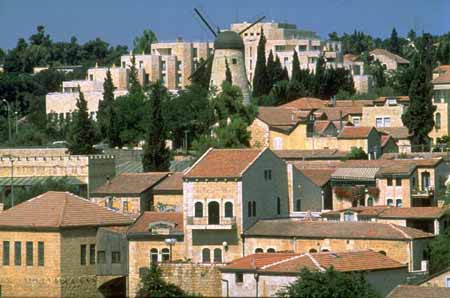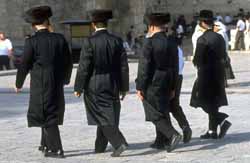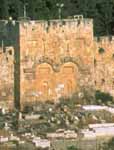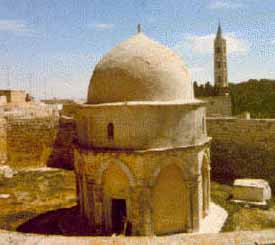Jerusalem: Beyond the Old City Walls
PLACES TO VISIT:
The City of David
The original City
of David, Jerusalem of ancient times, is not synonymous with the Old
City. In fact, it was located on a narrow ridge
south of the present-day Old City. This is the
traditional site of King David's tomb. The area is
also sacred to Christians because the "coenaculum"
or room of the Last Supper is located nearby.
The City
of David borders the Kidron Valley where the Gihon Spring, the
city's water source, is located. King David understood then, as do
Israel's leaders today, that control of the water supply is vital to the nation's survival.
One of David's successors, Hezekiah,
King of Judah in the 8th century B.C.E., also recognized the
importance of Jerusalem's water supplies. After Judah was invaded by
the Assyrian king Sennacherib, Hezekiah built a tunnel to divert the city's water supply to a reservoir. The men dug the
tunnel from both ends at once and met in the middle. It is possible to
wade through the water still in the tunnel and follow its snaking path
about a third of a mile (533 meters) under the city and exit at the
Pool of Siloam.
Yemin Moshe
In 1860, British philanthropist Moses
Montefiore built new housing on a hill overlooking the Old City to
help relieve the congestion and poverty in the Jewish Quarter. The first
of several developments was called Mishkenot
Sha'ananim. Today, a unique guest house is located there, which is
used by visiting writers and artists.
Yemon Moshe (Ministry of Tourism)
 |
This area is called Yemin Moshe, and easily
identifiable by the large windmill at the top of the hill overlooking
the Hinnom Valley on King David Street. The windmill, was originally
built to serve the milling needs of the residents of Montefiore's new
developments, but it was never operational because of the lack of wind
where it was situated.
A lovely (and pricey) restaurant is also located
just down the stairs from the windmill, which offers a spectacular
view of the Old City walls. To the left are much sought after homes in
what was once an artists' colony. The popularity of the area, however,
has driven prices up to the point where only one art studio remains.
A great route into the Old City is to walk down the stairs
past the windmill and through the Yemin Moshe gates to the street and
walk across and up the hill to Zion
Gate. This takes you into the city right near the Jewish
Quarter and is a relatively quick way to get to the Western
Wall.
Almost directly across the street from the windmill is
Liberty Bell Park, which was established in honor of America's bicentennial.
A model of the Liberty Bell is inside the park. Both the original and
copy are inscribed: "Proclaim liberty throughout the land unto all
the inhabitants thereof" (Leviticus
25:10).
King David Hotel (Ministry of Tourism)
 |
Walking downhill toward downton on the same side of the
street as Yemin Moshe is another beautiful park that also offers a great
view of the Old City and, just beyond that, the famous King
David Hotel, the most luxurious (read expensive) hotel in Israel.
Along with its reputation for its accommodations, the hotel is probably
best known as the target of a bomb by the Irgun,
the Jewish underground organization led by Menachem
Begin during the fight to gain independence from Britain. The hotel
was then the British military headquarters. The bombing on July 22, 1946, killed 91 people.
Across the street from the King David is the
International YMCA, one of the most beautiful Ys in the world. Its
152-foot tower is visible from much of the city and the view from the
top is unparalleled. The Y also has a hotel that offers reasonable
accommodations and inexpensive meals.
Mea She'arim
In 1873, Orthodox Jews founded a settlement a short distance from the Old
City, just north of Jaffa Road. It was just the second
neighborhood built outside the city walls, and was initially home to
100 families. The name Mea She'arim means "one hundred
gates" and comes from the biblical passage, "Isaac sowed in
that land and reaped in the same year a hundredfold" (Genesis
26:12).
Today, Mea She'arim is a unique neighborhood where
strict interpretations of Jewish tradition rule and people dress in a
manner common to Jewish ghettos of 18th and 19th century Europe. Women
wear long-sleeved shirts and skirts and those who are married usually
have shaved heads covered by wigs (sheitels) or scarves. The
men wear long black coats and fedoras or round, fur-covered shtreimels.
Some have long white stockings and knicker-like pants, and most have tzitzit hanging below their shirts. Young boys often have very long hair
(their first haircuts usually are not until they're three) and older
ones long sidecurls (peyis).
Orthodox Jews returning from the Western Wall (Ministry of Tourism)
 |
Mea She'arim is especially fascinating on Shabbat.
People are constantly in the street, coming to or from shul. Dozens of
tiny synagogues -- stiebels -- are scattered throughout the
neighborhood. Men and women sit separately, usually on different
floors of the bigger shuls. Go inside and you may find yourself in a
world you don't recognize, where the prayers, songs and rituals are
very different from those in even Orthodox synagogues elsewhere.
This is also the home of some of the more ardent
guardians of Judaism, who put up barricades to prevent cars from
driving by on Shabbat and protest the building of roads or
archaeological excavations in areas they believe may have been Jewish
burial sites.
Whatever your views on Orthodoxy, you should behave
respectfully when in Mea She'arim and other religious neighborhoods.
Signs are posted on buildings saying the Torah obligates women to
dress appropriately. See our tips on how to dress.
Mount Scopus
Ever since the Hyatt chain built a luxury hotel on
Mount Scopus, it has become a more common base from which to tour
Jerusalem. Coming from downtown, however, it's quite a hike up to
Scopus, so you'll probably want to go by taxi or bus. The main
attraction is the spectacular panoramic view of the city, the Hebrew
University and the Mount of Olives.
The Hebrew University is one of Israel's seven universities and an
excellent school that has outstanding departments in a wide range of
disciplines. The university also has numerous connections to the
United States, from the large number of students who spend their
junior year of college studying there, to the various institutes named
after or funded by Americans. To name just two, there is the The Harry
S. Truman Research Institute for the Advancement of Peace and the
Steven Spielberg Jewish Film Archive.
The University opened in 1925 and was followed by
the building of Hadassah Hospital in 1934. In April 1948, an Arab
force ambushed a Jewish convoy on the way to Hadassah Hospital,
killing 77 Jews, including doctors, nurses, patients, and the director
of the hospital. Another 23 people were injured. Mount Scopus was
subsequently isolated from the rest of Jerusalem by the Jordanians, and, though it remained under Israeli control, the
university and hospital were both closed and relocated in West
Jerusalem. After Jerusalem was retaken in 1967, they
reopened.
A controversial addition to Mount Scopus was the
Jerusalem Center for Near Eastern Studies built by the Mormons. A
beautiful building with a stunning view of the city, it provoked a
national debate because of concerns about Mormon missionary
activities. The Mormons agreed not to proselytize in the city and they
were subsequently allowed to create their center just down the street
from the university.
The Golden Gate (Ministry of Tourism)
 |
Visitors to the Mount of Olives stand on holy
ground. Nearly 2,000 years ago, Jesus stood on this hillside overlooking the Old City making prophesies that
would change the world. According to Jewish tradition, the Messiah will come through the Golden Gate (or Gate of Mercy) of the Old City
and bring about the resurrection of the dead in the cemetery on the
Mount.
Unlike the lush expanses of grass associated with
American cemeteries like Forest Lawn or Arlington, the Mount of Olives
is a mountainside of stones. One does not even see flowers adorning
the markers because Jews place a small
stone on the grave to indicate they have visited.
The cemetery sits atop a hill that was once dotted
with olive trees. Given the sanctity of the place, the cemetery's
terrible condition comes as a shock. Grave stones are broken and
scattered. Most of the damage dates to the Jordanian
occupation (1948-1967). On November 3 2014, three residents of the Jerusalem neighborhood of At-Tur were arrested on suspicion of smashing and breaking headstones in the Mount of Olives cemetary. The two younger suspects, aged 15 and 12, admitted to smashing dozens of headstones in the weeks prior to their arrest, while the 22 year old suspect denied involvement.
According
to Christian tradition, Jesus had a prophecy that Jerusalem would be
destroyed and went down to the Mount of Olives with his followers on
Palm Sunday. He then wandered around the city for about a week and
taught his disciples in caves on the Mount of Olives.
On
Thursday, the Jewish holiday of Passover,
Jesus went to a building on Mount Zion (near where
Dormition Abbey now stands at the southeast corner
of the Old City) and ate the Last Supper. He and two
disciples then left Jerusalem and went to Gethsemane and sat among the olive trees.
The grove, at the base of the Mount, is maintained
as it was nearly 2,000 years ago. The olive grove is
within the walls of the Basilica
of the Agony, which stands on the spot where Jesus
prayed prior to his arrest. It is located on Jericho
Road facing the Golden Gate.
Inside the Basilica, pilgrims try to empathize with
the suffering of Jesus. The church itself is spartan by European
standards, though it has impressive murals depicting the events that
took place in Gethsemane. A sculpture of thorns surrounds the spot in
the middle of the church where Jesus prayed. A beautiful colored
mosaic over the entrance depicts the acceptance of Jesus by the world.
Israel Fact
The
olives of the oldest olive tree in the Garden of
Gethsemane (derived from the Aramaic for "oil
press"), where Jesus was arrested by the
Romans, were flown to the Vatican for Pope John Paul
II. |
After
Jesus was arrested, he was taken a short distance up the hill to where Dominus Flevit ("The Lord Wept") now stands. It is beside the cemetery with
a narrow road in between. The grounds also contain a cave where
Jerusalemites buried their dead centuries ago. Families put the bodies
of loved ones in sarcophagi. Some time later, after the flesh had
rotted, the bones were removed and put In small boxes on shelves in
caves. Some of these boxes are still in the cave. What is particularly
significant about them is that Christian symbols were found carved on
the tombs of people with Jewish names. These are the oldest remains of
Jews who became the first converts to Christianity.
 |
According
to Christian tradition, after the crucifixion Jesus wandered
40 days on the Mount of Olives and ascended to heaven from
a point on the hill. A small shrine inside the walls of the
Greek Patriarchate contains stone stumps with crosses carved
on the tops that mark the spot where the disciples watched
the ascension.
Ironically, the Chapel of the Ascension is
now run by the Muslims, who built a dome over the rock from
which Jesus ascended to the heavens and upon which his footprint
can be seen. The Chapel is off the Mount of Olives Road, just
above the cemetery as you travel from Mount Scopus. Further
down the road is the Tower of the Ascension, today a small
Russian Orthodox Church, where Mary watched Jesus ascend to
heaven.
Though it has no particular historical significance,
the most impressive looking church in Jerusalem is probably
the Church of Mary Magdalene. This is the building that looks
like all the pictures you see of the Kremlin with golden onion
domes rising from the trees.
From the Mount of Olives, you can also see the
conical-roofed Absalom's Tomb and the pyramid-roofed Zechariah's Tomb.
These are tombs of anonymous second century citizens of Jerusalem and
have nothing to do with their biblical namesakes.
Ammunition Hill
Prior
to the Six-Day War, Ammunition
Hill was Jordan's most heavily fortified stronghold in divided
Jerusalem. Its central bunker served as a command post, mess hall and
storage area for weapons and other war materiel. A maze of trenches
and pillboxes on the hill were connected with the bunker. The battle
for Ammunition
Hill was fierce and cost the lives of 24 Israeli paratroopers. As
a result of the victory, Israeli forces could open the road to Mt.
Scopus and the fall of the Old City was greatly facilitated. These two
achievements were crucial to the reunification of the city. Today, a
memorial and museum are on the site.
Ma’ale Adumim
Ma’ale Adumim is a suburb
of Israel’s capital, barely three miles outside Jerusalem’s city
limits, a ten-minute drive away. It was established
by 23 families on a hilltop in 1975. Today,
it is the largest Jewish city in the West
Bank,
with a population of 27,300. Approximately 6,000
people live in surrounding settlements that
are included in what is referred to as the Ma’ale
bloc. These communities are part of the “consensus” settlements;
that is, those that most Israelis expect to be
incorporated into Israel when its final borders are determined.
Previous
Next
|